Raised beds are better than ground planting. It encourages good drainage, controls weed growth, and you can plant slightly close to each other. However, proper spacing between the plants is important.
As a general rule of thumb, you need to keep 6-18 inches of space between plants while planting them in raised beds. The space needed will vary from plant to plant. Also, keeping at least 18-24 inches between two rows will give you enough dirt piles for the plants as they grow.
Different growing methods require different spacing, so it is tough to declare exact measurements. This article will explore the importance of plant spacing in raised beds. We will also share a list of vegetables and their spacing requirements.
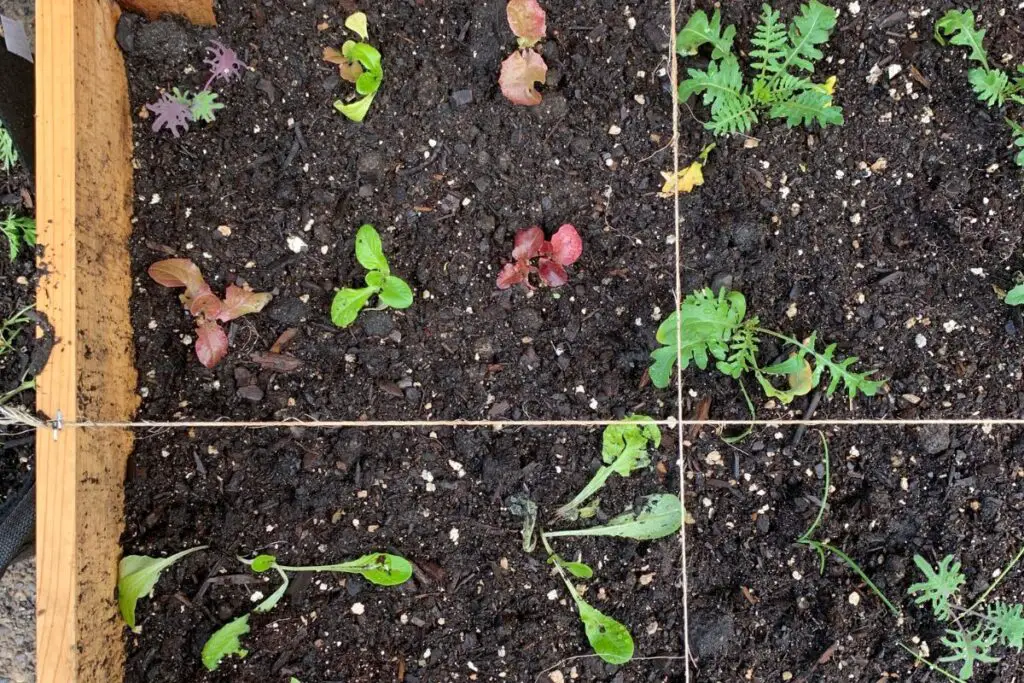
Why is spacing important in planting?
Keeping a reasonable space between plants is essential for the plants’ good health.
It encourages them to stay alive and keep growing in the long run.
If you place the plants or vegetables too close to each other, you will end up with stunted growth in your plants.
Each of them will climb over another, fight for nutrients and moisture, and become unhealthy.
Overcrowding leads to:
- Development of numerous diseases because the plants don’t get enough air circulation. Such places are great for the staying and spreading of pathogens.
- Since plant roots compete for nutrients, light, and moisture, you get lower harvests due to overcrowding.
At the same time, keeping too much space is not recommended.
- If there is a lot of space between the plants, weeds get an opportunity to grow in the empty spaces.
- Though raised beds suppress weed growth, there will still be weeds if you keep more than enough space between the plants.
- In the case of fruits and flowers, the plants will need pollination to produce flowers and fruits.
If your plants are planted very far away, there are lower chances of cross-pollination.
So, these are some common reasons you must keep sufficient space between the plants in raised beds.
Also read: How Deep Should A Raised Garden Bed Be? (With 40 Examples)
What about bio-intensive planting?
A lot of gardeners prefer bio-intensive planting in raised beds.
It allows you to plant multiple plants in one raised bed.
In this method, plants are grown close to each other so that the leaves can touch each other.
You can fit more plants in rows in a small space.
The method will not only increase your yields but will also protect the soil.
If planted close to each other, the plants themselves will act as mulches for each other.
With less space, the weeds will not get a chance to develop.
The low-growing plants will shade leaves, work as mulches for your raised beds, and encourage moisture retention.
However, no matter what method you own to get more yields from small spaces, at least maintain a few inches of distance for enough air circulation.
As long as your plants receive enough air, intensive planting will not create any issues.
Transplant vs. seed planting
The spacing during transplanting and seed sowing is different.
If you are sowing seeds, sow them a little close to each other for different germination rates.
Once the seedlings have reached a few inches tall, transplant them a few inches away from each other.
For example, while sowing cabbage seeds, maintain only 4-6 inches of space.
But once their seedlings reach a good height, shift them and keep 15-18 inches of distance.
Looking for gardening supplies? We have tested 100's of products before recommending them to you guys. Check out our best pick below:
| Image | Gardening Supplies | Best Price? |
|---|---|---|
 Top
Top Top
Top | Raised Garden Bed Kit | Check On Amazon |
 | XLUX Soil Moisture Meter, Plant Water Monitor, Soil Hygrometer Sensor for Gardening, Farming, Indoor and Outdoor Plants, No Batteries Required | No Results |
 Top
Top Top
Top | 82 Pcs Garden Tools Set and Extra Succulent Tools Set | Check On Amazon |
 | Joeys Garden Expandable Garden Hose with 8 Function Hose Nozzle, Lightweight Anti-Kink Flexible Garden Hoses, Extra Strength Fabric with Double Latex Core, (50 FT, Black) | No Results |
 Top
Top Top
Top | Dual Chamber Compost Tumbler | Check On Amazon |
 Top
Top Top
Top | Sunnyglade Plant Stakes | Check On Amazon |
 Top
Top Top
Top | Organic Cold Pressed Neem Seed Oil | Check On Amazon |
 Top
Top Top
Top | Mighty Mint Gallon :-Insect and Pest Control Peppermint Oil | Check On Amazon |
 Top
Top Top
Top | Scotts DiseaseEx Lawn Fungicide | Check On Amazon |
 Top
Top Top
Top | Jacks Classic 20-20-20 All Purpose Fertilizer | Check On Amazon |
 Top
Top Top
Top | 30,000 Seeds Pollinator Attracting Wildflower Mixture | Check On Amazon |
 Top
Top Top
Top | Survival Vegetable Seeds Garden Kit-Over 16,000 Seeds | Check On Amazon |
Spacing tips
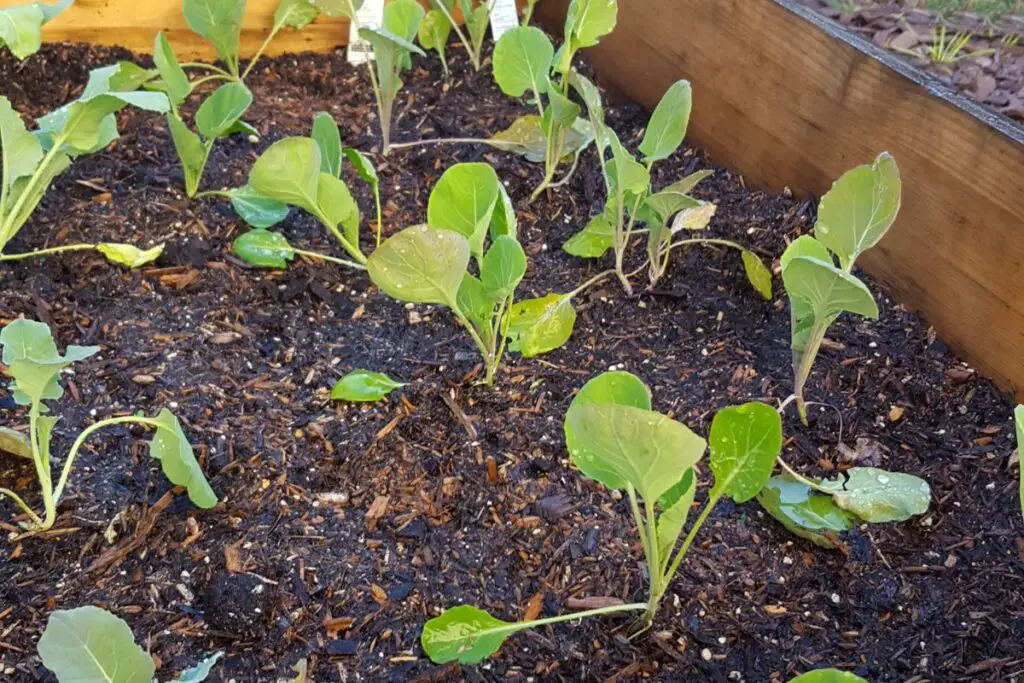
When you buy plants or seed packets, the packets contain information about the soil type and pH, planting depth and spacing, and other requirements like sun, water, nutrients, and temperature.
You can follow the same advice in your raised beds.
So, instead of throwing the packets away, please keep them to gather knowledge about every requirement, especially spacing and depth.
Here are some tips about the spacing of the plants and vegetables, which can help you get higher yields without any issues.
Also read: 7 Best DIY Raised Bed Soil Mix: A Step-by-step Guide
Select seeds as per your bed size
Depending on the size of your raised bed, you must choose the seeds carefully.
If you have a small size of bed but want more crops from that bed, choose the plants that can grow slightly overcrowded without any issues.
If you have a big bed, choose seeds that need sufficient spacing.
But also ensure that you don’t leave a lot of space between the plants or seeds.
Mounding increases the surface area.
Gardening in small raised beds is all about the bed’s length, width, and height and the vertical space on the top of your bed.
Mounding is a technique where you can increase the depth of your raised bed without digging the ground soil beneath the bed.
For example, potatoes grow around the stems.
Mounding along the stems and covering the lower leaves allows you to receive more surfaces to produce more potatoes.
Apply square foot garden techniques
Square foot gardening is a technique where a grid is kept over the bed, and in each grid, you plant plants or seeds.
For square foot gardening, you need to use a 4×4 foot raised bed and put 12×12 inch grids.
If you have more than one raised bed, keep at least a 3-4 inch space in between the bed.
The grid has square shapes, and each square can be further divided into more squares, like 4,9 or 16 small squares.
In each square, you can grow one single plant.
Since plants have different needs, you must divide the grids carefully.
For example, cabbage will require 15-16 inches of space.
It needs a whole square foot.
On the other hand, swiss chard can grow well in 4 to 1 square feet.
Skip the rows
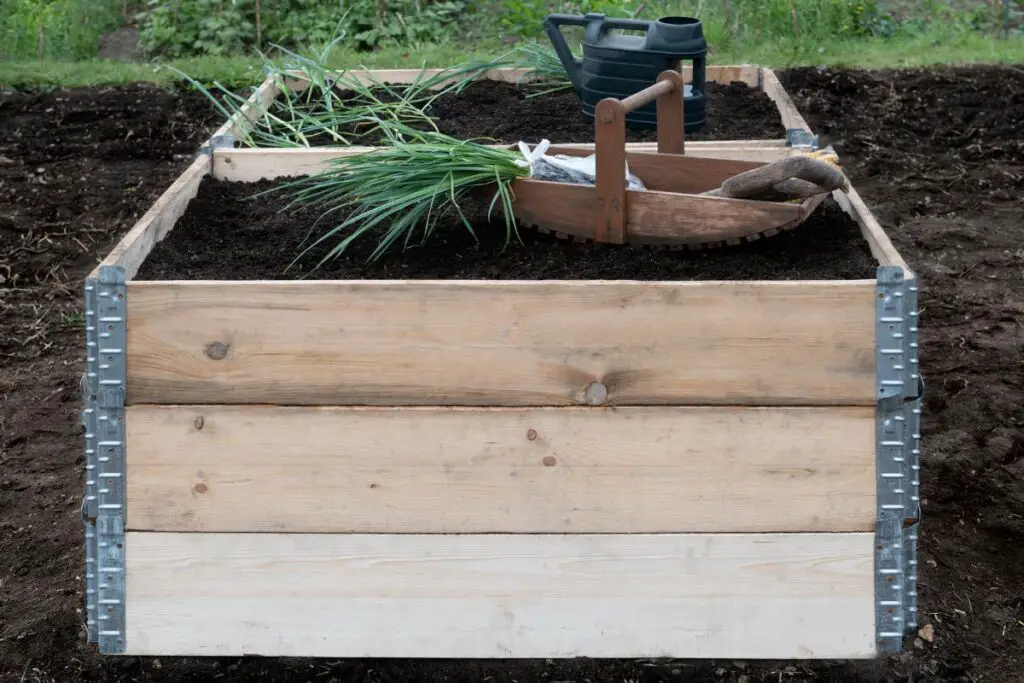
You can skip row planting if you have made circular or oval-shaped raised beds.
In most cases, the raised beds are made in a rectangular figure.
Sometimes, growers also make L-shaped raised beds where you get two figures, out of which one is rectangular.
But, if you have made circular raised beds, like hexagonal or octagonal, try circular planting instead of row planting.
Besides, you get more space for your plants in circular beds, giving your garden and the bed an aesthetic look.
While planting in such circular or oval-shaped raised beds, consider measuring the perimeter of the bed and the concentric rings from the center.
Place the perennials with the longest maturity at the center of the bed.
Then, surround the perennials with some vegetables you will frequently harvest.
Mound the center of the bed with compost or soil.
It will create more space in your bed.
Instead of perennials, you can also put a trellis at the center and grow some vine plants.
Another way of maintaining space in the circular raised beds is to stagger the plants.
When you buy seeds, they mention row spacing and plant spacing.
Ignore the row spacing and consider the plant space.
For example, if you have carrots and the packaging says 16 inches of row spacing and 2 inches of plant spacing, consider the plant spacing and ignore the row spacing.
While planting carrots, you can plant them in any shape, for instance, a diamond.
But make sure there is at least 2 inches of space between each carrot.
Repeat the same in other empty areas of raised beds.
Planting like this will increase the crop yield in a smaller space and avoid overcrowding.
Succession planting
In this method, you can increase yields in your raised beds despite having a limited space.
Along with that, you should maintain proper spacing.
Instead of planting all the seeds together, sow them after every few weeks.
This way, you can harvest during different times and get more space for planting some other crops.
You can also opt for multi-sowing, where you plant many seedlings together and then transplant the bigger plants to give the other plants some space.
Use trellises
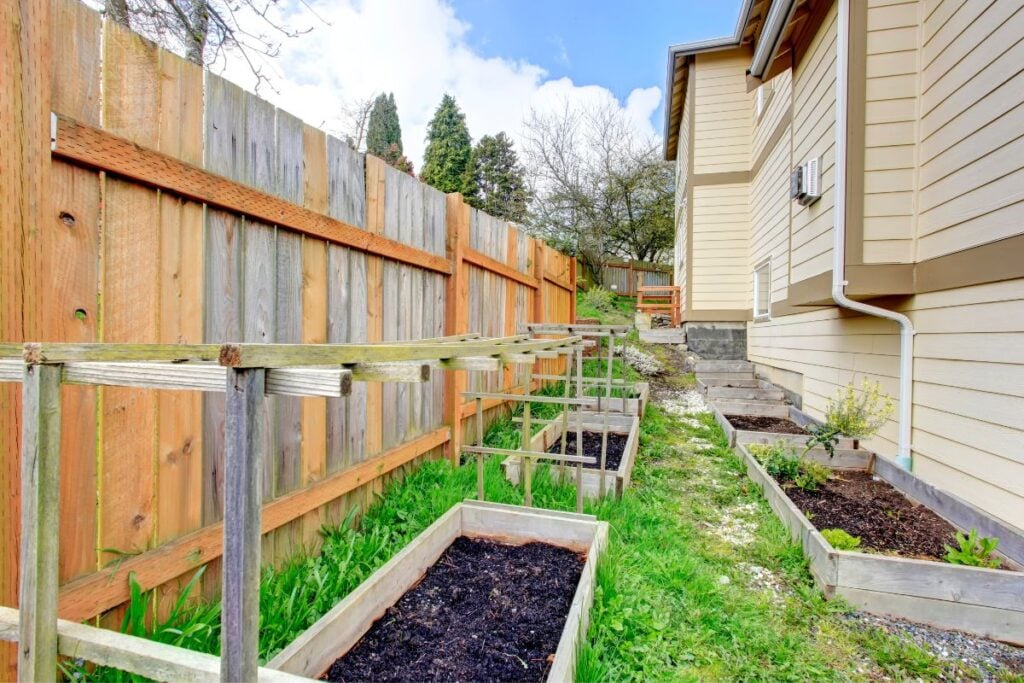
To grow lots of plants in a single raised bed, you can place trellises inside the bed.
They can add extra design to your garden.
Trellises allow you to grow the plants vertically instead of horizontally.
That is why you will receive more plants from a single bed.
For trellises, squashes, melons, cucumbers, beans, and peas are good vegetables.
From a limited space, you receive a maximum number of yields.
Besides, these plants will stay much better than those growing in the ground because they will receive enough air circulation.
The more air they get, the better they will be.
Pick the right companions.
Companion planting is where you plant multiple plants with the same requirements in the raised bed.
These not only make the bed look better and more colorful but also help in managing pests and diseases and increase the yields of each other.
For example, planting marigolds beside tomatoes will repel pests and pathogens.
Besides, a flower and a vegetable side by side will look great.
Plant vegetables from the allium family like onions and garlic with other vegetables like spinach or beans.
However, don’t plant too many plants together from the same family.
Otherwise, pests attracted to a certain family can destroy all the crops.
For example, certain insects are attracted to the allium family.
So, if you plant onion and garlic together, all your plants will get destroyed.
List of vegetables and their spacing requirements in raised beds
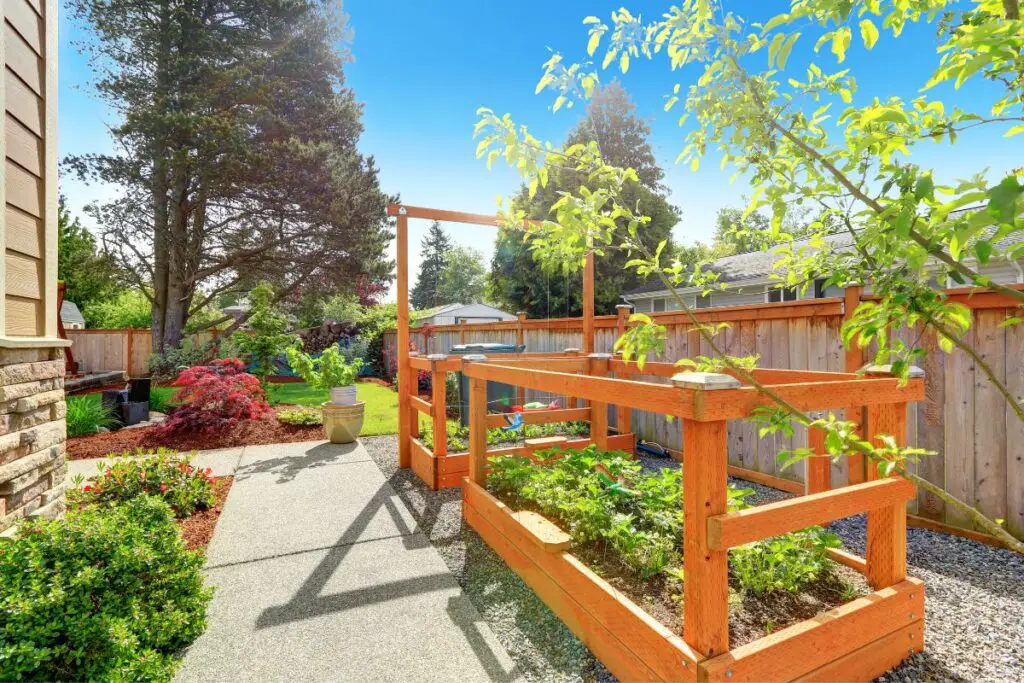
As I mentioned multiple times, different plants have different spacing needs.
To know how far apart you should plant them, research their growing conditions and then plant them.
However, to help you a little, below, we have shared a list of vegetables and how far you should plant them in raised beds.
Please review them to ease your confusion and reduce your research timing.
| Vegetable names | Spacing |
|---|---|
| Peas | 1-2 inches apart |
| Leeks | 2-3 inches apart |
| Carrots | 2-3 inches apart |
| Radishes | 2-3 inches apart |
| Pole beans, Bush beans, Fava beans, and Yardlong beans | 2-3 inches apart, 3-4 inches apart, 4-6 inches apart, and 4-6 inches apart, respectively |
| Beet | 3 inches apart |
| Cucumbers (trellis and raised beds) | 4-6 inches apart and 12-18 inches apart |
| Garlic | 3-4 inches apart |
| Onions | 3-4 inches apart |
| Parsnips | 3-4 inches apart |
| Shallots | 3-5 inches apart |
| Turnips | 3-6 inches apart |
| Kohlrabi | 3-6 inches apart |
| Lettuce leaf and head | 3-6 inches apart and 10 inches apart, respectively |
| Broccoli raab (broccoli rabe, rapini) and Normal Broccoli | 4-6 inches apart and 15-18 inches apart |
| Arugula | 4-6 inches apart |
| Chives | 6 inches apart |
| Kale | 6-8 inches apart |
| Bok choy | 6-8 inches apart |
| Spinach (Malabar and New Zealand) | 6-8 inches apart |
| Celery | 6-8 inches apart |
| Chinese cabbage | 6-9 inches apart |
| Swiss Chard | 6-9 inches apart |
| Corn | 8-10 inches apart |
| Endive | 8-12 inches apart |
| Okra | 10-12 inches apart |
| Collard greens | 10-12 inches apart |
| Sweet potatoes | 10-12 inches apart |
| Potatoes | 12 inches apart |
| Jerusalem artichokes | 12 inches apart |
| Cauliflower | 12-15 inches apart |
| Peppers | 12-15 inches apart |
| Asparagus | 12-18 inches apart |
| Eggplant | 12-18 inches apart |
| Brussel sprouts | 15-18 inches apart |
| Cabbage | 15-18 inches apart or 9-12 inches apart |
| Squashes | 18-24 inches apart |
| Tomatoes | 18-24 inches apart |
| Tomatillos | 24 inches apart |
| Gourds | (15lbs, 15-20 lbs, 30+ lbs) 18-36 inches apart, 36-48 inches apart, 48-60 inches apart |
| Pumpkins | 24-36 inches apart |
| Artichokes | 24-36 inches apart |
Final thoughts
Maintaining proper space between plants is very crucial. It allows the plants to breathe and grow better.
If grown too close to each other, the plants will get overcrowded. Due to this, the plants keep fighting for nutrients and moisture, ending up with stunted growth. Besides, overcrowding can lead to diseases due to a lack of air circulation.
On the contrary, too much space is also not good as that will lead to weed growth, no matter how better raised beds are at suppressing weeds. Since different plants have different growth systems, there is no specific spacing distance. Some require more space, and more need less.
That is why we have shared a table listing different vegetables and their spacing in raised beds. Consult the list before planting any veggies from the list.
Reference: ScienceDirect, American Society of Agronomy, Noble Research Institute, Soil for Raised Beds, Raised Bed Gardening.
